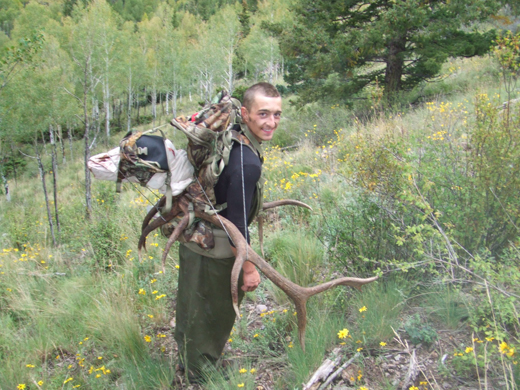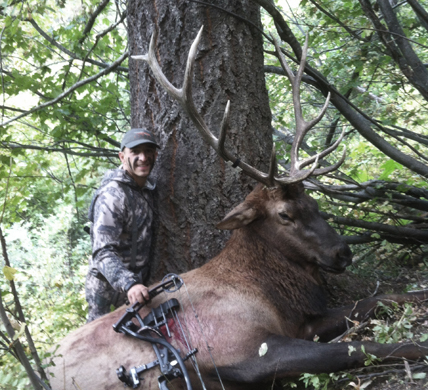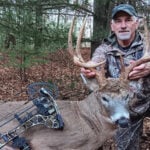LAST UPDATED: May 1st, 2015
Big bull tactics start and end with your ability to find elk to hunt. You can’t kill a big bull where big bulls don’t live. When I think of a big bull, I’m talking the herd bull variety; the loner bull that establishes its dominance mid August when pecking orders are solidified. A bull that has had survived long winters, numerous predators, and has quite a few years under his belt. These big bulls are often call shy, determined to maintain their herd, and in my experience are lovers not fighters. There’s many ways to hunt these timorous wonders, but I want to break down some different tactics depending on the timing of your pursuit. These are not the normal techniques you read about, but ones that may have you at full draw on a wise monarch.
To be successful at killing BIG bull elk, it helps to understand them and the fact that they are different from the rest of the herd.
The bones of an elk weigh over a hundred pounds and make up the foundation of this mountain athlete. Man has a bone structure at or around 30 lbs. A mature bull has a 10lb heart pumping blood to a network of dense muscle that enables it to maneuver rough and unforgiving country. Man’s heart weighs less than a pound and is taxed as soon as he steps on the uneven ground the elk call home. Bulls are boss when it comes to the mountains, their four legs (to our two legs) coupled with lungs that are three times as big as ours, drastically tip the odds in their favor. They also have us beat when it comes to vision and olfactory senses. Each eye of an elk can rotate independently and their wide-angle lens squashes our view. The elk’s nose has several hundred million receptor sites compared to our trivial five million. So with all of these comparisons, it is safe to say that it’s time to be extremely meticulous with the tactics we use to harvest a big bull.
Tactic 1 – Early September Calls and Glassing
Most years, herds are gathered up by the first few days in September, but a lot of the gathering is done by overzealous satellite bulls that have no chance of maintaining the duty of breeding cows. Biology has not come to fruition yet, so not all herd bulls have swooped in and put these satellites in their place. The bulls are bugling, but mainly location calls and little aggression. I believe this is when big bulls are most vulnerable. They’re headed to breeding grounds and many will size each other up over the first ten days of September. If you’re interested in bringing a big bull within bow range, this could be the best time. My first choice tactic for this time of year, depending on the topography, is to sit behind glass and find bulls on the move.
For best results, try to spread out your time in the field and cover as much of the month of September as possible.
If you’re tucked into timber country, then partner up into a shooter and caller scenario with soft and subtle call cows. You can bounce around ridgelines, wallows, and other high traffic areas and find yourself a mature bull rounding up ladies. Don’t expect to hear much bugling, and if you do, know that the big bulls want the ladies to come to them, not the other way around. This is where it’s imperative to have your shooter out in front, 70 yards or so, with an arrow on the string and the wind in their face. You cannot fool an elk’s sense of smell. This is a challenging time to get a bull down, but I definitely believe it to be your best chance of getting within range of him.
When I first started elk hunting about 13 years ago, I would only take a week’s worth of vacation and did so around the 3rd week of September. Sure, you will hear a lot of bugling around then, but years of cutting my teeth has convinced me that the best time to kill a big bull is right around the time that herds are being established. Rather than take a full week off, perhaps trickle your vacation time through the entire month utilizing 3 and 4 day weekends to pursue your target.
Tactic 2 – Mid September Go Silent
Put the calls away, pack light, and run silent and deep. This is going to be different then the prototypical technique of getting a bull to answer, sneaking in close to him, putting a caller 80 yards back, two shooters up front in a “V” formation. The caller would start with soft mews building up to more aggressive estrous sounds. This technique probably works for a lot of folks still, but it has been my experience that this is a surefire way to call in a desperate satellite bull at best. Most herd bulls are lovers, not fighters. You get too close to them with a bugle and they’ll round up the harem and leave you in their dust.
So, rather than trying the same technique over and over with the same results, mix it up. Tactic 2 may require you to run feverishly at a big bull’s bugle. Closing on a bull requires a certain mentality. There are no halfhearted approaches, no time to second guess, you simply go! You will make noise when in pursuit but don’t worry because elk break brush too…. so press on. Once you feel that you’ve closed the distance to less than 100 yards, search for an elk trail, stay on it, minimize your noise, and always keep the wind in your face. If your timing is right, the herd should be either on their way to their bedding area or milling around within their bedding area. The herd bull will bugle periodically and when he does, you must hone in on his exact location. This is challenging because sometimes a bull will sound further away than he really is because his head is pointing away from you during his bugle. Hearing and deciphering a bugle are extremely critical for proper positioning. I typically only sneak in on a bull if he’s either pushing his cows to the bedding area, raking a tree, or bustling back and forth with satellites.
While a lot of emphasis is placed on “calling”, sometimes a quiet approach is necessary.
These satellite bulls can really help distract the herd bull while closing the distance and keep him vocal. Getting your shot off is going to require that the bull to be unaware of your presence. A timely cow call from your reed may stop the bull in his tracks, right in your lane as you’re at full draw. This will be the last sound this bull will ever hear as your arrow zips through him like butter. These are just a few notes from my evolving playbook. I will say that almost all of my herd bulls harvested have happened between September 15th-22nd and not a one was called into my lap. Be sneaky, and try the “run silent run deep” tactic.
Tactic 3 – Late September Dispersion
Playing off of tactic 2, this one also requires some physical “go-ahead” and gumption. I find the end of September to be the hardest time to get a mature bull to let his guard down. By now he’s warded off the satellites, and he’s the man in charge. You can get him to answer your calls, but he’s not leaving the ladies. He also has a secure perimeter of satellite bulls that can hinder you from moving in on him. Your chances of getting this old bull to walk away from all his cows just to check out your sounds are slim. This is when I give the herd bull the full court press.
Once he answers my locator bugle I dive right in at him once the herd has bedded for the day. After you’ve gotten in pretty close, he will get nervous and most likely get the herd to vacate perfect. If you can get this bull moving his cows you can bet that he’s going to have to bugle very often. This is where I zone in on his every bugle and answer back with the meanest bugle I can muster. The herd will move fast and you will need to be in shape, but this controlled chaos may deliver a shot opportunity. My goal is to split up the herd, get the cows confused, and let the satellites squirm with excitement. The amount of bugles should skyrocket, and the patience of the mature bull will run thin, as long as you can keep up.
This particular tactic requires that you be in top physical shape in order to keep up with the herd and slip an arrow into a big, mature bull.
This tactic is hard to employ, but can have you mixing things up with several bulls for the rest of the day. Keeping the wind favorable is going to be hard as well, but generally the elk will be scattered and you will be dodging eyeballs left and right. You may earn a shot just by keeping up, or potentially diminish the bull’s patience and turn him into a fighter, not a lover. It may happen fast, or this may take several hours and many miles to get the bull somewhat cornered. In my experience, bulls will move their herd to a few locations before finally turning on you. Your job is to stay undetected from the cows and to simply keep up and apply pressure.
Helping Hand
The majority of my elk hunting experience comes from making mistakes and hunting with mentors. I’ve hunted twice with Larry D. Jones who practically invented elk calling. I have other mentors that have more elk hunting experience than years I have been alive. They’ve been there and done that. I’ve just managed to learn from them throughout the years and I hope that you can do the same. I’ve purchased elk tags in WA, WY, CO, NM, MT, and ID. I’ve hunted different terrain, private, public, roads, and backcountry. Some years I’ve killed three bulls, others I’ve sipped on tag soup. It’s all about continually evolving your game and methods to best serve your ability and experience. Employ some new tactics this year and show up in shape.
The author has been fortunate to have learned from some of the best elk hunters in the country.
Still, his commitment to physical preparation is perhaps his greatest asset.
Conclusion
September is my favorite month and probably yours too. The three tactics I’ve covered here are really just cliff notes. However, the bottom line is that your tactics have to evolve. My tactics are probably not the norm, but I can promise that I’ve tried them all. You probably already know from experience that big bulls are truly challenging to get close to; let alone drive a sharp broadhead through. But don’t fret. Just keep mixing things up and be prepared to work your butt off for that one precious shot opportunity. Good luck and may your fletching be saturated with red.









